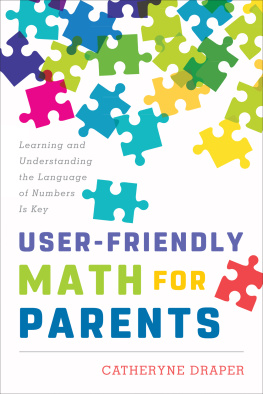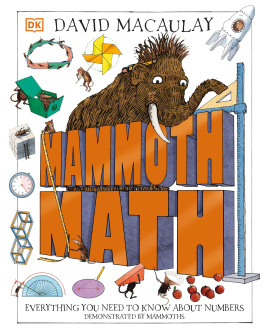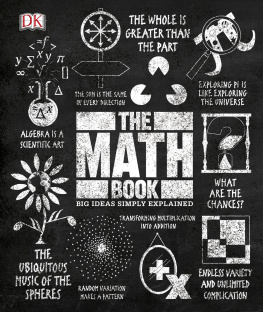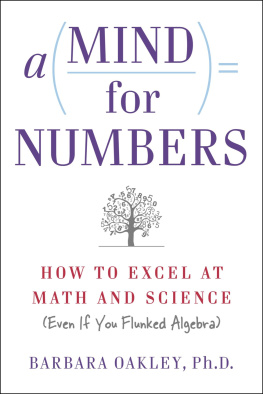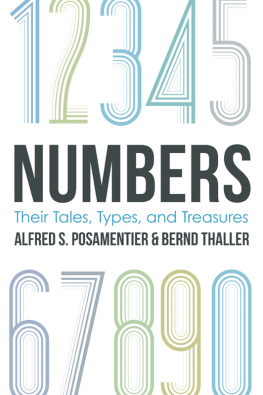numbers
&
other math ideas
come alive
Also by Theoni Pappas
THE JOY OF MATHEMATICS
MORE JOY OF MATHEMATICS
MATHEMATICAL SCANDALS
MATH STUFF
MUSIC OF REASON
MATHEMATICAL FOOTPRINTS
MATH-A-DAY
MATH TALK
THE MAGIC OF MATHEMATICS
FRACTALS, GOOGOLS & Other Mathematical Tales
MATH FOR KIDS & OTHER PEOPLE TOO!
THE ADVENTURES OF PENROSE
THE FURTHER ADVENTURES OF PENROSE
MATHEMATICAL SNIPPETS
THE MATHEMATICS CALENDARS
THE CHILDRENS MATHEMATICS CALENDARS
Copyright 2012 by Theoni Pappas.
All rights reserved. No part of this work may be reproduced, copied or transmitted in any form or by any means without written permission from both the copyright owner and Wide World Publishing/Tetra.
Without limiting the rights under the copyrights reserved above, no part of this publication may be reproduced, stored in or introduced into a retrieval system, or transmitted, in any form or by any means (electronic, mechanical, photocopying, recording or otherwise), without written permission of both the copyright owner and the publisher of this book.
Portions of some stories in this book have appeared in previously published works by Pappas.
Wide World Publishing/Tetra
P.O. Box 476
San Carlos, CA 94070
web sites:
http://www.wideworldpublishing.com
http://www.mathproductsplus.com
First Printing March, 2012 ISBN: 978-1-884550-63-8
First e-book format edition 2012 ISBN: 978-1-884550-64-5
To
my parents
Frances and James
and
Elvira
for her encouragement
with these stories
Contents
Contrary to popular belief, math is not just a bunch of math facts and concepts that never change or evolve. Every math idea or problem takes time to evolve while it percolates in the mind of the mathematician. Imagination and mathematics have always been closely connected. In fact, mathematics is pure fantasy but with one very important elementlogic. Each new idea that is created or uncovered must follow logically from previously established concepts, regardless if they are some new type of number, a definition, a theorem, or other math notion. They must be shown to be consistent with previous ideas. Looking at the history of mathematics we realize that new ideas were oftentimes not readily accepted. Some were even considered blasphemous, ridiculous or downright dumb. Look at Leopold Kroneckers vicious and insidious attack on George Cantors innovative work on set theory and transfinite numbers, consider mathematicians negative reaction to the negative integers when they were first introduced to the European continent or how the Pythagoreans tried to keep the discovery of the 2 secret. Consequently, in many of the stories in this book the interactions and dialogues between many of the math characters are often contentious. There are doubts, harsh challenges and animated questioning. Just as it is human nature to often resist change and revolutionary ideas, so the math characters are reticent to accept mathematical newcomers. Yet, in the end, challenges and questions yield to logical thought and proofs similar to how ideas are actually scrutinized in the world of mathematics.
In NUMBERS & OTHER MATH IDEAS COME ALIVE numbers and math ideas tell us their stories in their own words. We learn about their foibles and strengths. We see why mathematicians had to develop new concepts when the old ones were not sufficient for the problems at hand, and how math is constantly growing and evolving. We learn how new numbers appeared, and old ones had to accept the newcomers, and how certain math ideas lay hidden for centuries, until, they were resurrected or discovered by a mathematician. Love, hate, anger, excitementall emotions we associate with humans are taken on by these math characters as their stories unfold. Hopefully you will be intrigued as you look behind the scenes at what numbers, points, lines, and other notions are saying and thinking. In each story, math properties and characteristics are uncovered and explained through the dialogues and actions of the math characters. In fact, you may forget you are actually learning mathematics as you get caught up in the characters private lives.
numbers
&
other math ideas
come alive
number is merely the product of the mind. Karl Gauss
N umberville is a town full of solutions. The population is infinite and only composed of numbers. It is where mathematicians look for solutions to the host of problems they are continually creating.
The recent election results in Numberville came as a surprise to numbers. Most thought there was no way the so called Reform Party would get elected, but by some quirky circumstances, the finite elite subset of whole numbers {0,1,2,3,4,5,6,7,8,9} were the only ones that voted. And, yes, you guessed it, the Reform Party was elected. Most of us did not realize what this meant. We numbers had become accustomed to the status quo, and were so into our own properties and factors that we had become oblivious to certain situations developing in Numberville. Apparently the numbers in this subset of whole numbers were accustomed to being one unit apart and did not like being crowded by all the new numbers that were arriving. First there were the proper fractions, who liked to socialize, and soon mixed numbers and improper fractions were all over town. Then the irrational numbers started arriving on geometric objects such as the sides of right triangles or diagonals of squares. As new and complicated problems developed, they provided many more solutions involving new numbers. Consequently, there was not as much work for whole numbers as there had been in the past. But this did not bother them because they received hefty royalties from the other numbers.
Apparently what these elite whole numbers objected to was the way these new numbers were hanging around town in no apparent order. Before the newcomers had arrived, they had always kept things neat and themselves in ascending and descending order. This was important to them so that they could easily find a number that might be needed for a particular solution. Other numbers thought this was not necessary, and besides they did not want to be told where and near whom they always had to be. Only the fractions and the irrational numbers suspected the real reason. The whole numbers were not skilled at distinguishing the size of numbers other than themselves. So the first thing that the Reform Party did was pass the ORDINANCE OF ORDERAll numbers must display their decimal equivalents when in public places. No number could remain out of sequence for more than 10 minutes.
"Just think of having to drag around an infinite tail of nonrepeating digits all day long! "
Needless to say when this ordinance was posted, protests could be heard all across town. First the fractions and other rational numbers gathered signatures and presented their petition which claimed that the ordinance was an invasion of privacy. But the Reform Party simply said the petition was preposterous and rejected it.
The irrational numbers became very agitated by this arbitrary decision and decided to hold a protest. They held their demonstration in front of city hall holding up their radical signs in protest of the ordinance.
Once again the Reform Party members ignored the protests, and warned them that they were in violation of the ORDINANCE of ORDER and they threatened them with fines unless they displayed their decimal equivalents at this public gathering and arrange themselves in order.


